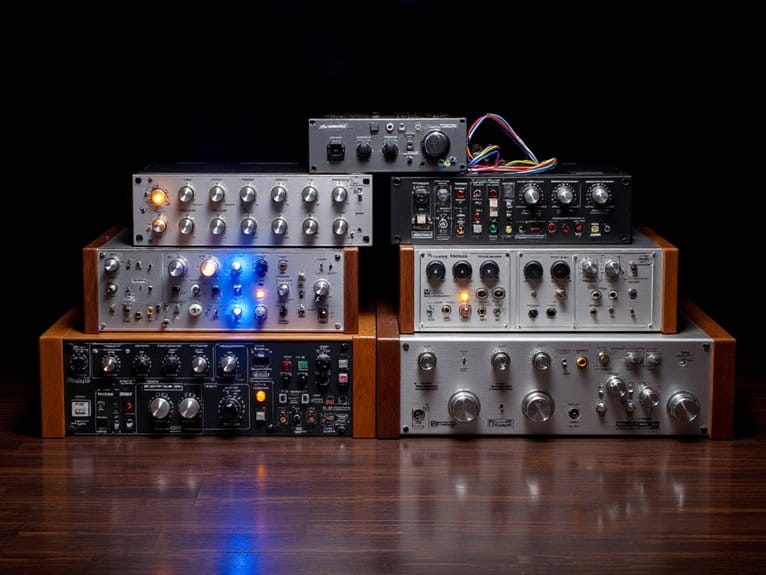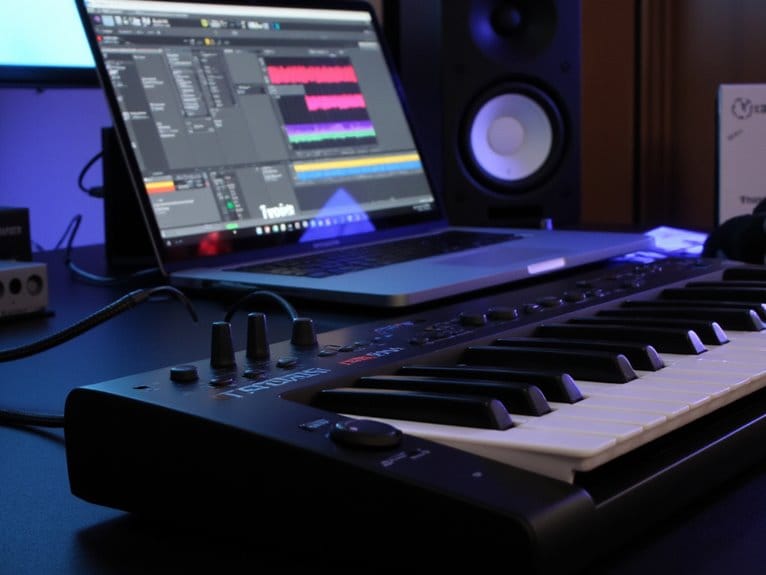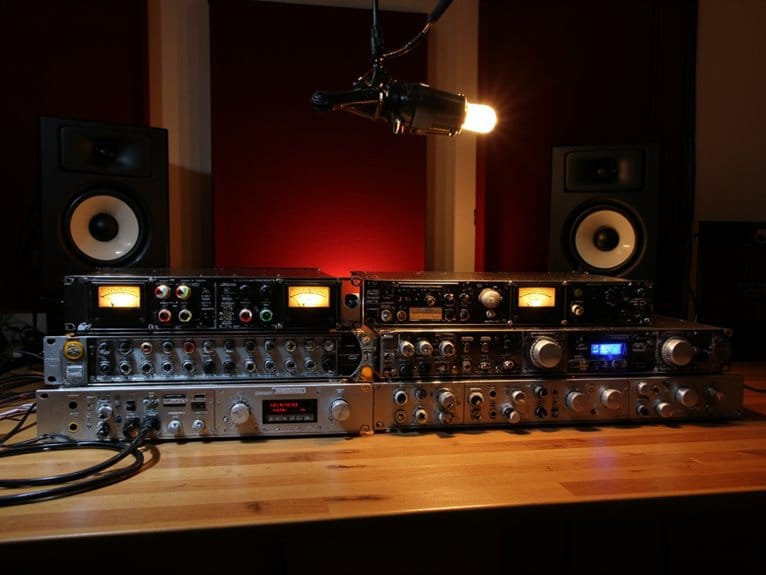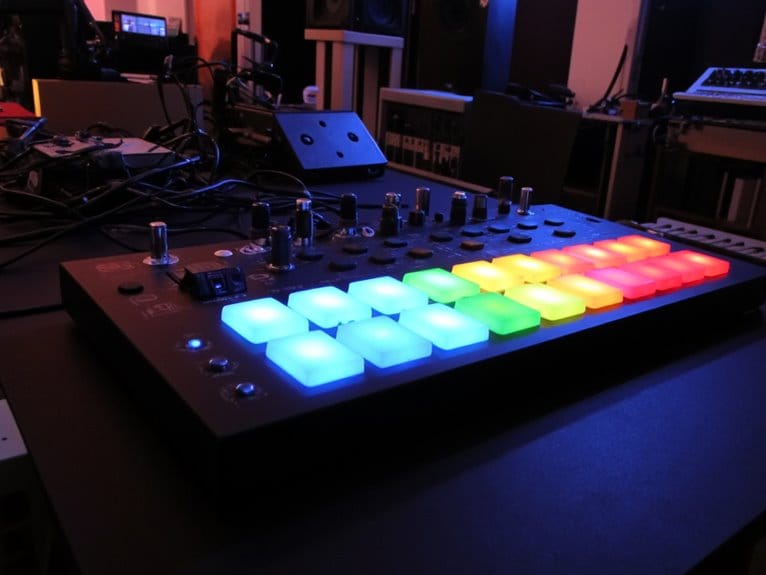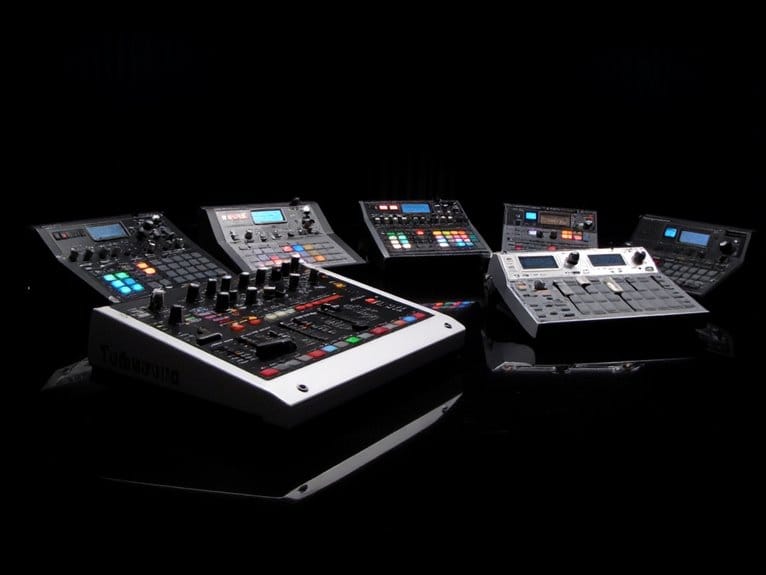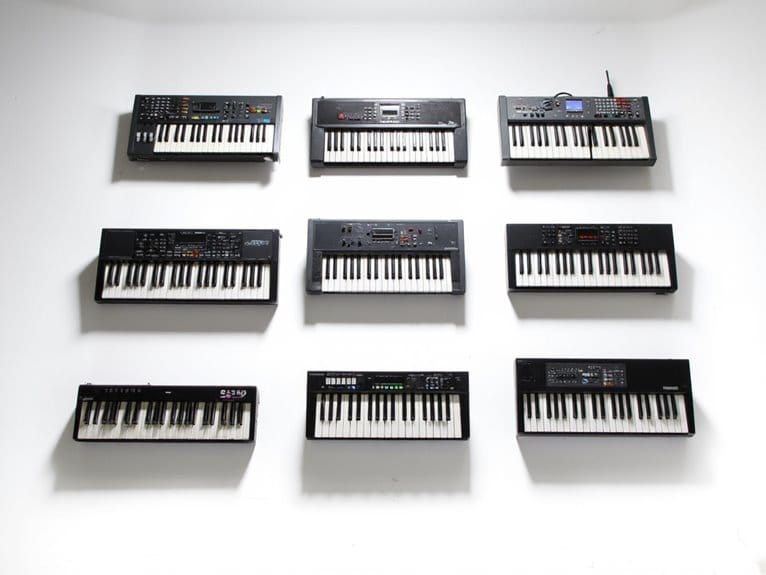Best Modular Synths for Electronic Music Producers
I’ve tested dozens of modular synths this year, and the standouts include the Donner ESSENTIAL L1 with its authentic 3340 VCO sound and 64-step sequencer, the ultra-portable Nanobox Lemondrop for granular textures, and Behringer’s impressive 2600 Gray Meanie offering 93 patch points at an accessible price. The Korg Volca Modular remains perfect for beginners, while the Arturia MicroFreak delivers hybrid versatility with seventeen oscillator types. Each model serves different creative needs and budgets, with specific considerations that’ll help determine your ideal choice.
We are supported by our audience. When you purchase through links on our site, we may earn an affiliate commission, at no extra cost for you. Learn more.
Notable Insights
- The Behringer 2600 Gray Meanie offers 93 patch points and vintage analog character at an affordable entry price point.
- Korg Volca Modular provides beginners with 8 modules, 50 patch points, and battery-powered portability for mobile creation.
- Arturia MicroFreak combines 17 oscillator types with comprehensive modulation matrix for hybrid synthesis exploration.
- Cre8audio East Beast delivers high-quality 40HP analog synthesis with dual desktop and Eurorack functionality.
- MOOG Mavis offers authentic analog sound below $300 with semi-modular design and Eurorack integration capabilities.
Korg Volca Modular Micro Synthesizer
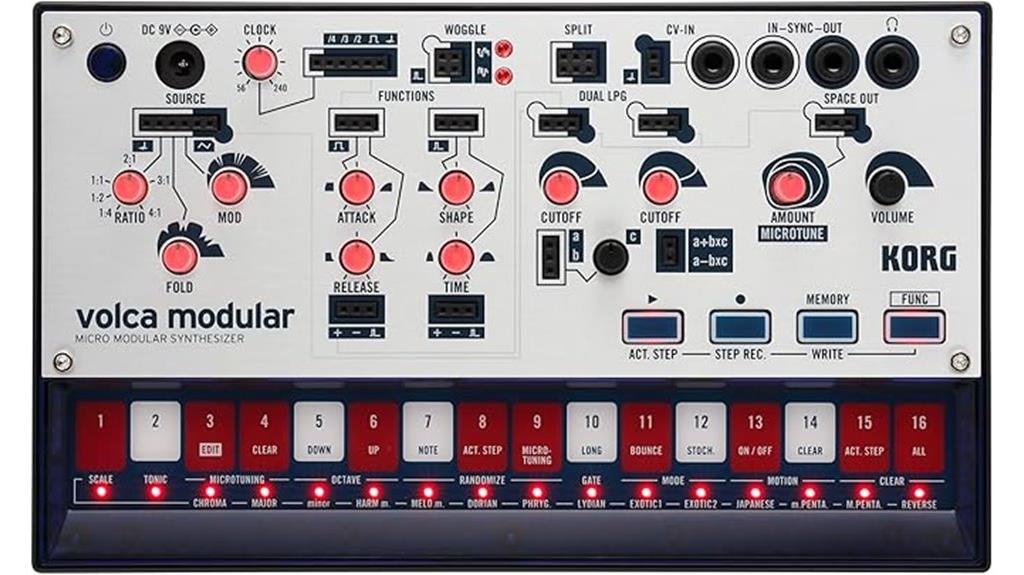
Eight independent modules and fifty patch points make the Korg Volca Modular Micro Synthesizer the perfect entry point for musicians who’ve been intimidated by the complexity and cost of traditional modular systems. You’ll appreciate the color-coded inputs and reference sheet that eliminate guesswork when patching, while the built-in 16-step sequencer keeps your creative workflow moving without external gear. The analog VCOs deliver that coveted fat sound with digital tuning stability, and you can stack all three oscillators for impressively thick textures that rival much larger systems. At 1.8 pounds with battery power, it’s genuinely portable for sketching ideas anywhere.
Best For: Musicians new to modular synthesis who want an affordable, portable entry point with analog sound quality and educational value through hands-on patching experience.
Pros:
- Color-coded patch points and reference sheet make modular synthesis approachable for beginners
- Genuine analog VCOs with digital tuning stability deliver fat, thick sounds when stacked
- Compact 1.8-pound design with battery power enables truly portable music creation anywhere
Cons:
- Limited to only 8 pattern storage slots with manual switching between patterns
- No MIDI out functionality and lacks filter modulation control via MIDI
- Small knobs can be difficult to manipulate precisely during performance or programming
Arturia MicroFreak Synthesizer Keyboard (25-Key Hybrid Synth)
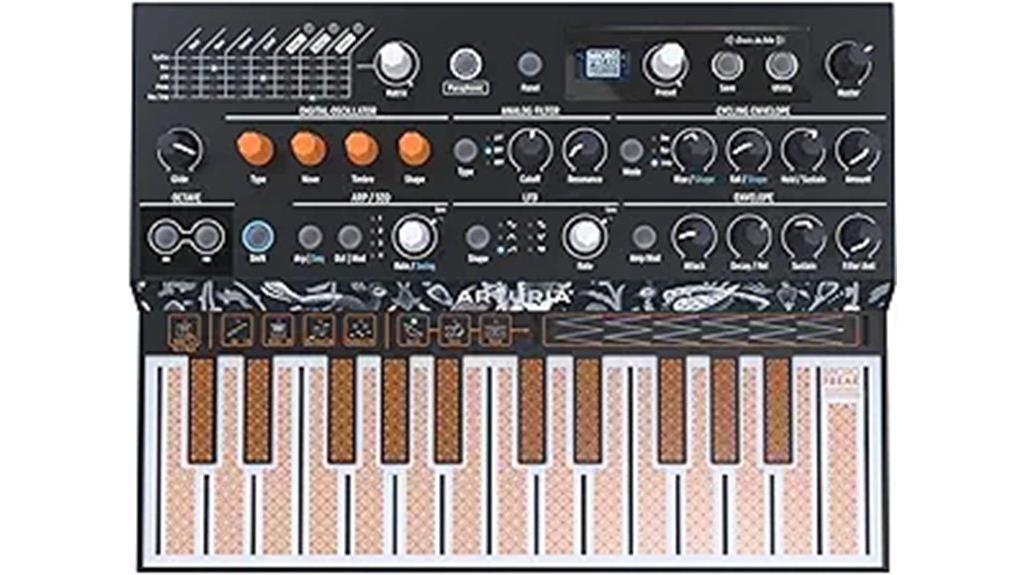
The Arturia MicroFreak stands out as the ideal entry point for producers who want to explore modular synthesis without the intimidating price tag or complex patching requirements of traditional Eurorack systems. This 25-key hybrid synthesizer delivers seventeen oscillator types, including coveted Mutable Instruments modes, through its innovative capacitive touch keyboard that detects individual note pressure without moving parts. You’ll find the 5×7 modulation matrix particularly compelling for rewiring signal paths, while CV outputs let you control external gear seamlessly. Though it lacks onboard effects and requires patience with its touch-sensitive interface, the MicroFreak’s paraphonic capabilities and thorough sequencer make modular exploration surprisingly accessible for electronic music production.
Best For: Producers seeking an affordable entry into modular synthesis with extensive sound design capabilities and modern digital oscillator types without the complexity of traditional Eurorack systems.
Pros:
- 17 oscillator types including premium Mutable Instruments modes and innovative capacitive touch keyboard with individual note pressure detection
- Comprehensive 5×7 modulation matrix and CV outputs for seamless integration with external modular gear
- Strong paraphonic sequencer with automation recording, Spice and Dice functions, and excellent sound design potential
Cons:
- No built-in effects requiring external processing for audio enhancement
- Capacitive touch keyboard can be unpredictable and sensitive, affecting playability for some users
- Steep learning curve for beginners unfamiliar with hardware synthesis concepts and workflows
Cre8audio Semi-Modular Analog Synthesizer (East Beast)
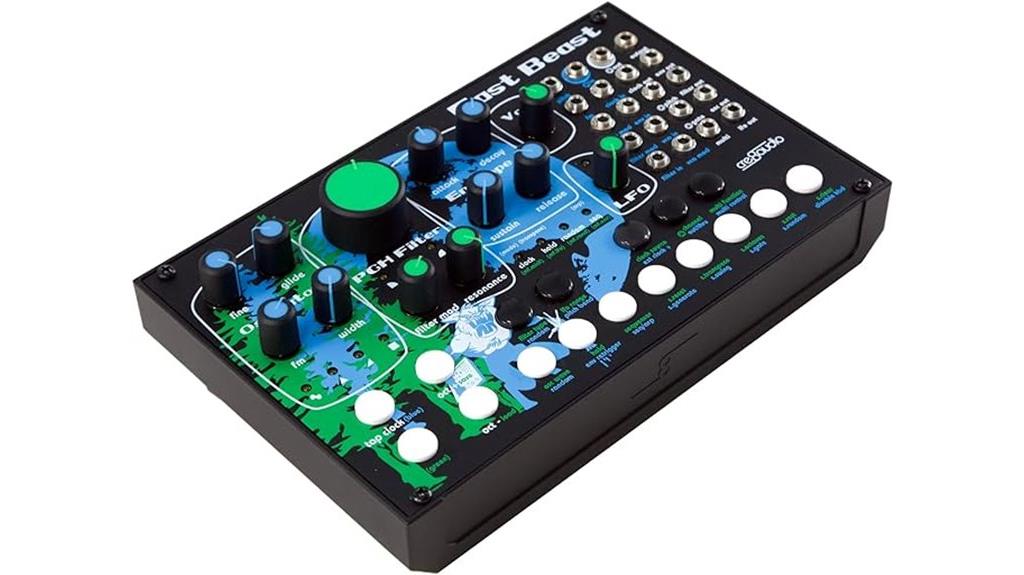
When you’re seeking an affordable entry point into modular synthesis without sacrificing the authentic analog experience, Cre8audio’s Semi-Modular Analog Synthesizer stands out as a compelling 40HP powerhouse that bridges the gap between desktop convenience and Eurorack expansion. This East Coast-style synthesizer delivers those coveted fat analog sounds through voltage-controlled oscillators and subtractive synthesis, while its multi-mode filter maintains excellent quality without dead spots throughout its range. You’ll appreciate the extensive package including patch cables, MIDI pigtails, and power adapter, making it immediately playable upon arrival. The 2.5-pound metal construction feels substantial, and its 4.5-star rating reflects genuine user satisfaction with both sound quality and build integrity.
Best For: Musicians and producers looking for an affordable entry point into modular synthesis with authentic analog sound quality and the flexibility to expand into Eurorack systems.
Pros:
- High-quality multi-mode filter with no dead spots and excellent subtractive synthesis capabilities
- Complete package includes all necessary accessories (patch cables, MIDI pigtails, power adapter) for immediate use
- Dual functionality as both desktop synthesizer and 40HP Eurorack module for future expansion
Cons:
- Limited to East Coast synthesis style, which may not suit all musical preferences
- Only 40HP of modular space may feel restrictive for users wanting extensive modular capabilities
- At 2.5 pounds, it’s heavier than some portable desktop synthesizers
MOOG Mavis Standalone Semi-Modular Analog Synthesizer Kit
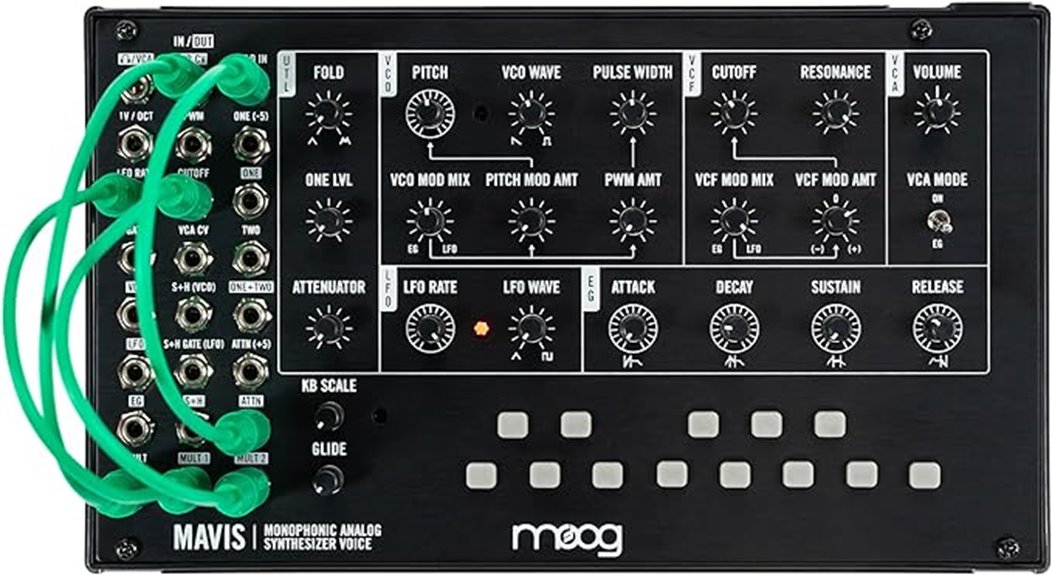
Building your first modular setup doesn’t have to drain your savings account, and I’ve found the MOOG Mavis Standalone Semi-Modular Analog Synthesizer Kit proves this point beautifully with its sub-$300 price tag. This 44HP kit delivers authentic Moog sound through dual oscillators, ladder filter, and wavefolder, combining classic subtractive synthesis with additive wavefolding techniques that’ll expand your sonic palette considerably. While assembly’s required, you’ll get everything needed including patch cables, calibration tools, and protective cover, plus the flexibility to integrate into Eurorack systems later through 24-point CV control.
Best For: Beginners seeking an affordable entry into analog synthesis and experienced users wanting to expand their modular setups with authentic Moog sound quality and flexible Eurorack integration capabilities.
Pros:
- Combines classic subtractive synthesis with additive wavefolding for versatile sound design at an affordable sub-$300 price point
- Includes comprehensive kit with all necessary components plus built-in keyboard for standalone use and 24-point CV control for Eurorack integration
- Delivers authentic Moog sound quality through dual oscillators, ladder filter, and wavefolder in a compact 44HP format
Cons:
- Assembly required which may intimidate beginners unfamiliar with synthesizer construction
- Built-in keyboard has limited musicality and the unit lacks a power switch for convenient operation
- Lower output sound level compared to other Moog oscillators may require additional amplification in some setups
Factors to Consider When Choosing a Modular Synth
When I’m helping musicians choose their first modular synth, or expand an existing setup, I’ve found that five key factors consistently determine whether they’ll love their investment or regret it six months later. Power requirements often get overlooked until you’re staring at a beautiful module that your case simply can’t support, while rack space planning becomes essential as your collection inevitably grows beyond what you initially imagined. Your sound design goals, budget constraints, and how well the system integrates with your existing gear will ultimately shape every purchasing decision you make.
Power Requirements and Consumption
Although I’ve assembled countless modular setups over the years, I’ll admit that power considerations still catch me off guard sometimes—nothing quite compares to the frustration of connecting that perfect module only to discover your power supply can’t handle the additional load. Most modules require 12V power, though you’ll encounter some needing 5V or 15V, so compatibility with your case becomes essential. Power consumption varies dramatically, from efficient modules drawing 20mA to power-hungry processors exceeding 200mA. I always calculate my total power budget before expanding, accounting for those LED-packed sequencers and touchscreen modules that consume considerably more juice. Don’t forget additional effects units either—they’ll impact your overall consumption and could push you beyond your supply’s maximum ratings.
Rack Space Planning
The puzzle of rack space planning resembles arranging furniture in a studio apartment—every square inch matters, and poor decisions become glaringly obvious once you’re living with them daily. I calculate HP (horizontal pitch) requirements meticulously, ensuring my case accommodates current modules while leaving breathing room for expansion. Power consumption becomes critical here, as cramming modules into insufficient cases leads to unstable voltages and disappointing performance. I group modules by functionality—oscillators near filters, sequencers adjacent to utilities—creating logical signal paths that minimize cable spaghetti. Patch cable accessibility matters more than I initially realized; tightly packed modules create frustrating bottlenecks during creative sessions. I’ve learned to allocate 20-30% extra space for future acquisitions, because module acquisition syndrome strikes everyone eventually.
Sound Design Goals
Before diving into specific modules, I establish clear sound design objectives that’ll shape every subsequent purchasing decision, because wandering into modular synthesis without sonic goals practically guarantees expensive confusion and buyer’s remorse.
I determine whether I’m pursuing rich ambient pads, punchy basslines, or experimental textures, since each direction requires fundamentally different module combinations and synthesis approaches. Polyphony requirements greatly influence my choices—complex harmonic layers demand polyphonic modules, while aggressive lead sounds work perfectly with monophonic setups.
I prioritize modules offering diverse synthesis methods like granular, subtractive, or FM capabilities, expanding my sonic palette beyond basic oscillator-filter combinations. Essential modulation sources, including LFOs and envelopes, become non-negotiable for creating dynamic movement and evolving textures.
Finally, I evaluate patch points and connectivity options, ensuring seamless integration with existing gear while maintaining routing flexibility for future expansions.
Budget and Expansion
Every modular synthesizer purchase demands careful financial planning upfront, since what appears affordable initially can quickly escalate into thousands of dollars once you factor in essential accessories, expansion modules, and the inevitable case upgrades that accompany a growing system. I recommend starting with semi-modular synthesizers, which offer immediate functionality while providing expansion pathways that won’t require rebuilding your entire setup from scratch. Individual modules typically cost between $100 and $500 each, and you’ll need patch cables, power supplies, and cases that greatly impact your total investment. I’ve learned to budget for ongoing maintenance and upgrades, as the modular ecosystem constantly evolves with new technologies that’ll tempt you toward continuous expansion.
Connectivity and Integration
Since modular synthesizers thrive on interconnectivity, I’ve found that choosing modules with robust connectivity options determines whether your system becomes a cohesive instrument or a collection of isolated sound generators. I always prioritize CV/GATE/SYNC I/O capabilities because they’re essential for seamless integration with other modular gear and CV-compatible devices, creating dynamic modulation networks that breathe life into static sounds. MIDI connectivity through USB-C or TRS connections has become increasingly important in my studio workflow, allowing effortless communication with DAWs and other MIDI instruments for synchronized performances and recordings. Audio input/output features greatly expand sound design possibilities by routing external signals for processing, while ensuring Eurorack compatibility regarding dimensions and power requirements prevents costly integration headaches that I’ve learned to avoid through experience.
Learning Curve Complexity
When I first dove into modular synthesis, I quickly realized that the creative freedom comes with a learning curve that can feel overwhelming, especially if you’re shifting from traditional keyboards or software synthesizers. The manual patching process demands understanding signal flow between oscillators, filters, and envelope generators, terminology that varies greatly across different manufacturers. I’ll admit, those first sessions involved more confused cable-swapping than actual music-making, as the limitless customization options can paralyze decision-making rather than inspire creativity. However, I’ve found that online communities, tutorial videos, and dedicated forums become invaluable resources for maneuvering through these initial hurdles, transforming what initially feels intimidating into an engaging exploration of synthesis fundamentals and modular relationships.
On a final note
I’ve tested dozens of modular synths over the years, and these eight units represent the sweet spot between functionality, affordability, and creative potential. Whether you’re drawn to the Behringer 2600’s vintage warmth, the MicroFreak’s hybrid engine, or the Nanobox’s granular capabilities, each offers distinct sonic territories worth exploring. Start with your budget, consider your space constraints, then let your ears guide the final decision.

